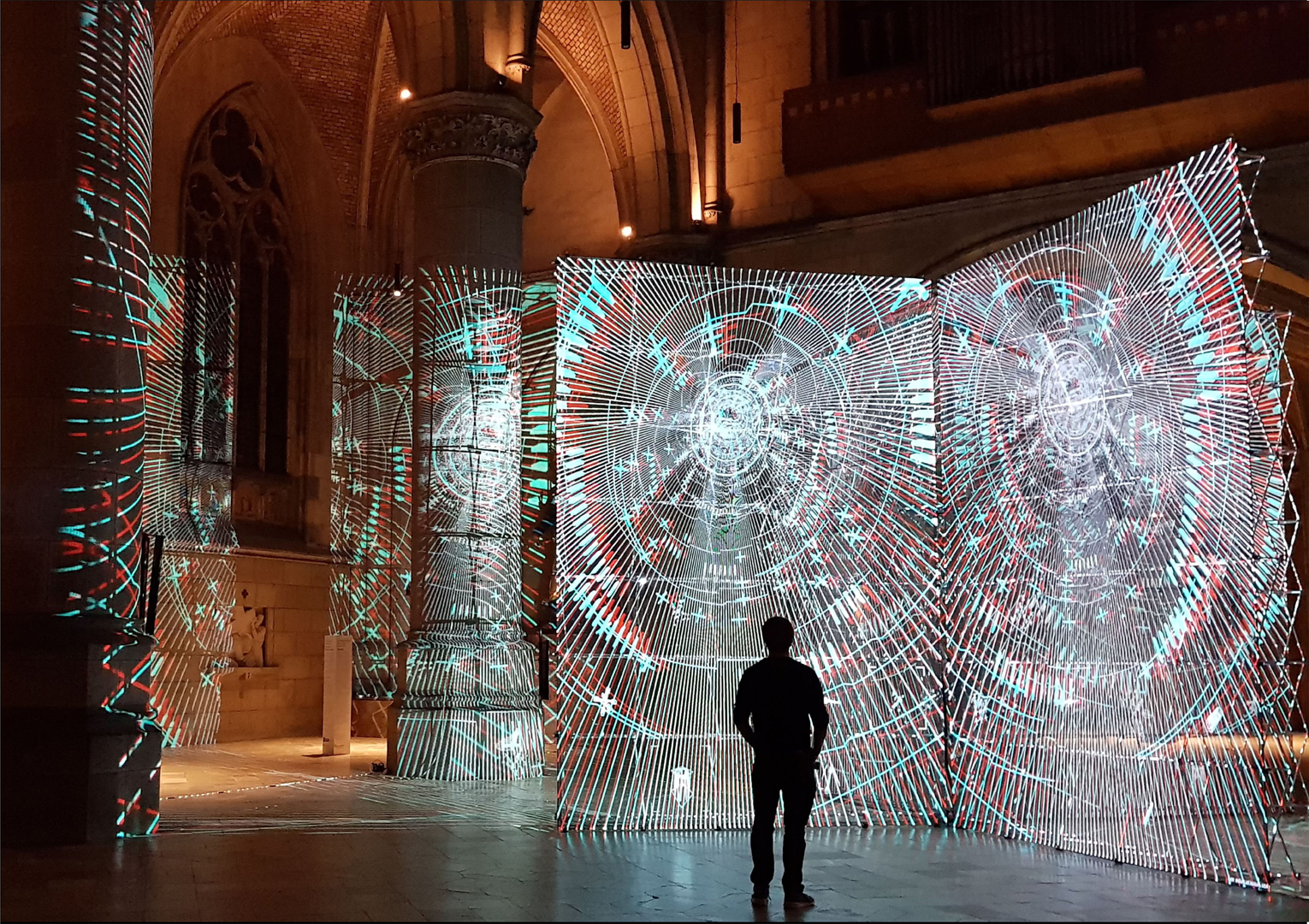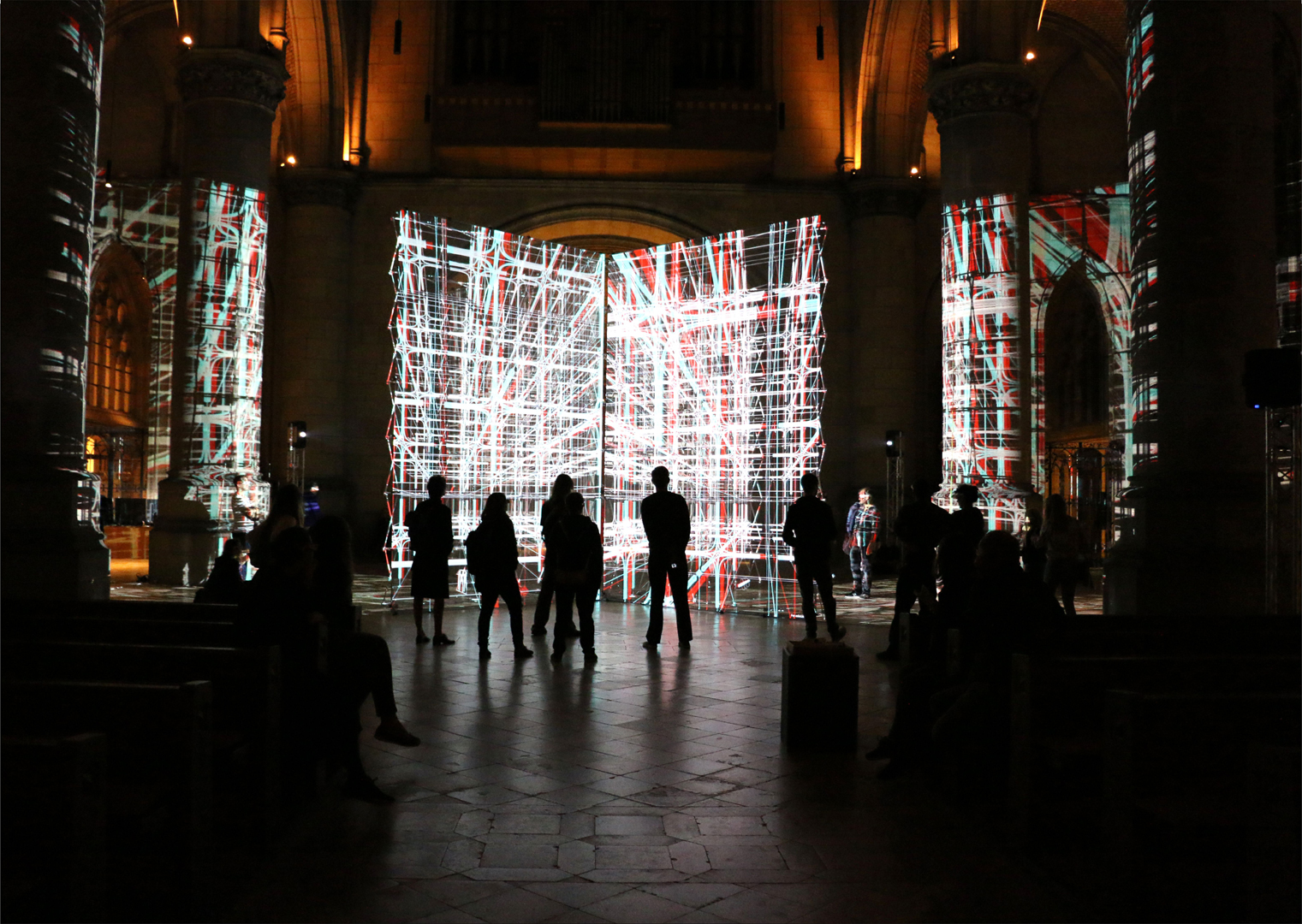Uwe Rieger, Yinan Liu, Roger Boldu, Haimo Zhang, Heetesh Alwani, Suranga Nanayakkara: LightTank
Artist(s):
Title:
- LightTank
Exhibition:
Category:
Artist Statement:
Summary
LightTank is an interactive Extended Reality(XR) installation that explores hybrid design strategies through the fusion of digital information and physical constructions. Designed for a public setting, the project expands the principles of contemporary augmented reality (AR) devices from a single person viewing experience, towards a communal multi-viewer event.
Abstract
LightTank is an interactive Extended Reality (XR) installation that augments a large lightweight aluminium structure with holographic line drawings. It consists of four transparent projection walls which are assembled to an X shape tower like construction of 7.5 x 7.5 x 5.5 m.
The project was developed for the Ars Electronica Festival and presented in the Cathedral of Linz in Austria. It aims to expand principles of augmented reality (AR) headsets from a single person viewing experience, towards a communal interactive event. To achieve this goal, LightTank uses an anaglyph stereoscopic projection method, which combined with simple red/cyan cardboard glasses, allows the creation of 3D virtual constructions.
The holographic line drawings are designed to merge with its physical environment, whether it is the geometrical grids of the aluminium structure or the gothic architecture of the cathedral. Certain drawings seem to peel off the existing physical structure, while others travel through the cathedral and line up with the characteristic elements like columns, groined arches and rose windows.
The project follows a hybrid design strategy which places equal attention to both design aspects, the physical and the digital. The aim of the setup is to explore user responsive architecture, where dynamic properties of the virtual world are an integral part of the physical environment. LightTank creates hereby a multi-viewer environment which enables visitors to navigate through holographic architectural narratives.
Technical Information:
LightTank aims to re-connect a virtual digital world with the multi-sensory qualities of site, space and structure. The installation was conceived by the arc/sec Lab for Cross Reality Architecture and Interactive Systems with sensing solutions developed by the Augmented Human Lab at the University of Auckland
LightTank’s main constructive system consist of a delicate space-frame structure that supports four large transparent projection walls. These are assembled to an X shape in plan view. The spaces between the walls are monitored by four LiDAR laser scanners, creating an interactive volume to detect user engagement.
LightTank takes advantage of two principles to generate large-scale free-floating imagery. One is the use of a gauze fabric as a projection carrier and the second is the projection of stereoscopic imagery. Different to one-directional theatre
effects, the LightTank setup does not have a front and backside. It generates a 3-dimensional holographic volume that can be inhabited and viewed from all directions.
LightTank achieves an all-round viewing solution by rendering stereoscopic images with multiple perspectives on the four- sided transparent gauze structure. This allows for viewing and interaction from multiple positions. The projected scenery consists of two components: small activation icons and large spatial digital constructions. The small holographic icons are rendered with a short distance viewpoint and allow a `touch` at arm`s length. Monitored by the four LiDAR scanners, these icons enable the visitor to trigger and control the large constructive animations. Once activated they expand over the whole screen and are rendered for two opposing, long distance viewpoints.
The virtual constructions are calibrated 1:1 to superimpose the physical environment. The combination of physical structure, sensors and digital construction creates a user interactive and inhabitable hybrid sculpture, blurring the boundaries between the tactile and the virtual.
The aluminium space-frame structure is self supportive. The 4 panels are to assemble an ‘X’ shape tower like construction of 7.5 x 7.5 x 5.5 (m). 4 x small 2D LiDAR scanners including and 4 x active speakers mounted onto the structure. The LiDAR scanners are each respectively connected to a raspberry Pi, which is used to compute and optimise the data, it is then sent through a modem to the main rendering computer. The virtual 3D world is constructed and rendered using Unity3D. The physical environment is replicated to size in order to achieve the best 1:1 calibration of the physical and digital. The installation uses a 4 channel spatial sound system. As the virtual constructions fly through space. The sounds are rendered spatially. 4 projectors are mounted on 4 self standing truss columns, surround the installation. Each projector facing one wall panel. 1 computer is placed nearby the installation with 4 screens to monitor the operation each projector.







